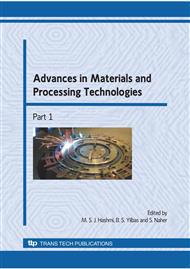p.601
p.611
p.616
p.622
p.630
p.637
p.646
p.654
p.661
Determination of the Optimal Ball Grinding Parameters for the Bio-Ceramics ZrO2 on a PC-Based Multi-Axis CNC Engraving Machine
Abstract:
The objective of this study is to determine the optimal ball grinding parameters of the bio-ceramics ZrO2 by executing the Taguchi’s L18 orthogonal array experiment, analysis of variation (ANOVA), and the full factorial experiment on a PC-based multi-axis CNC engraving machine. The manufacture of a ZrO2 coping using the optimal ball grinding parameters has also been studied based on a tooth plaster model via reverse engineering technique. The 3D data points of a tooth plaster model were digitized by the developed on-machine measurement system on a PC-based CNC multi-axis engraving machine by integrating a circular triangulation laser probe with the machine and a PC. A CAD model of a coping could then be constructed by Pro/Engineer software, based on the digitized 3D data points. With the help of the PowerMill CAM software, the machining path of a coping has been simulated, and the correspondent NC codes have been generated to fabricate the ZrO2 coping using the determined optimal ball grinding parameters, on the CNC multi-axis engraving machine. The average surface roughness of Ra=0.49 um for the ground ZrO2 ceramics coping could be obtained by utilizing the optimal flat surface grinding parameters.
Info:
Periodical:
Pages:
630-636
Citation:
Online since:
December 2009
Authors:
Price:
Сopyright:
© 2010 Trans Tech Publications Ltd. All Rights Reserved
Share:
Citation:


